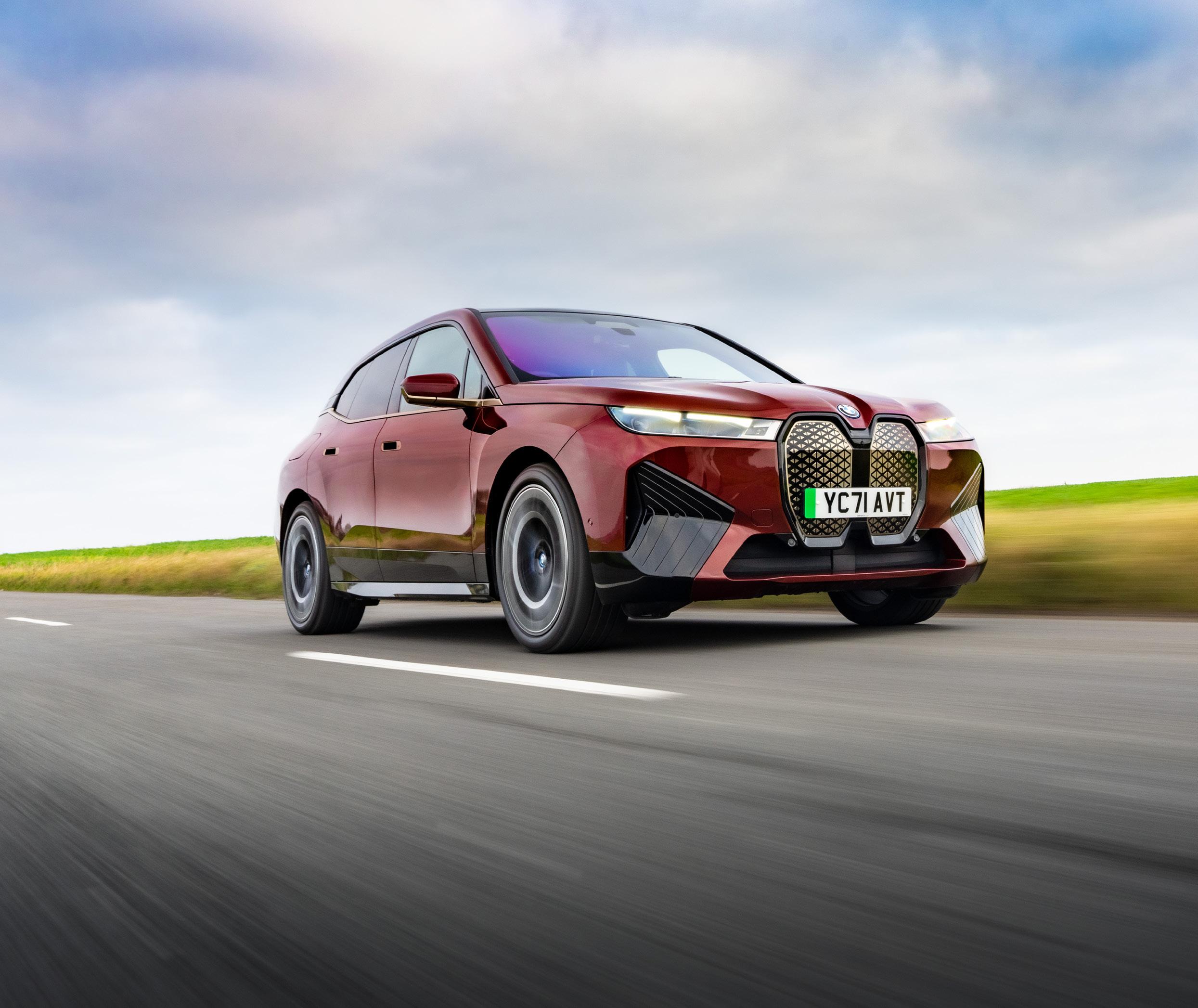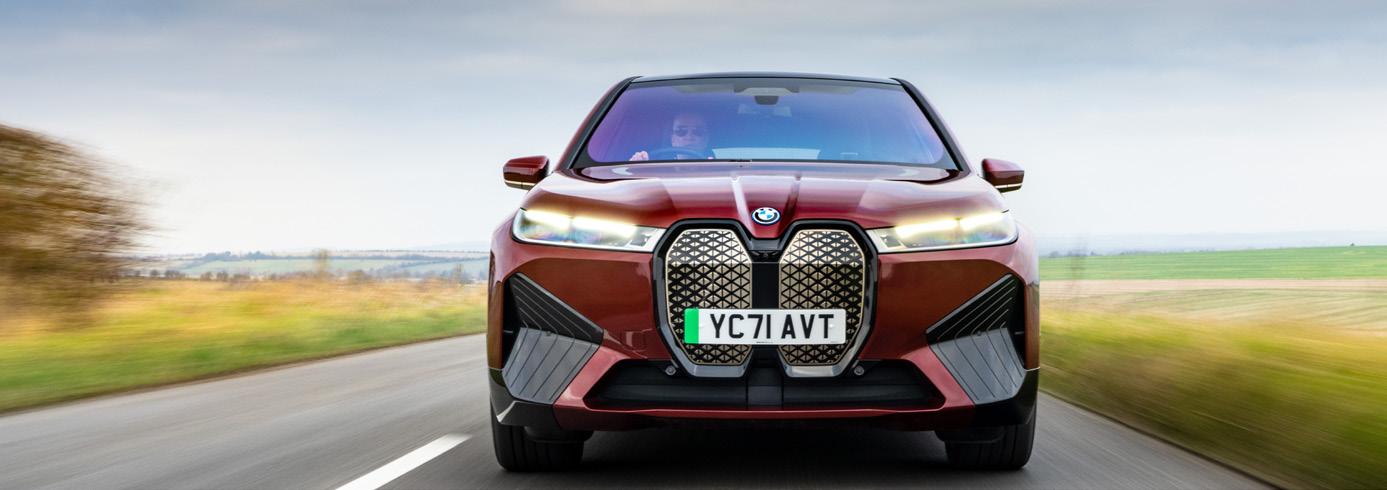
5 minute read
BMW iX
from GreenFleet 145
by PSI Media
As witnessed by the i3, BMW has history in blazing EV trails, and Richard Gooding finds that the iX all-electric SUV is another important car for the brand
Model tested: BMW iX xDrive50 M Sport
What is it?
BMW is one of the car manufacturers that was first out of the blocks when the call of modern-age vehicle electrification arrived. The i3 was launched amid a blaze of publicity in 2013, and was distinct in style and manufacture, some of its body structure made from CFRP (carbon fibre reinforced polymer) to save weight. That i3 production only stopped in August 2022 signifies how right BMW’s original idea was. It’s much the same thinking behind the iX. Similarly to the i3, CFRP is used in the car’s construction, but the car itself couldn’t be more different. A five-seat large SUV, the iX offers luxury and a high level of technology, and its importance is equal to the i3 – it is the first model based on a new, modular, scalable platform toolkit, on which the whole future of the BMW Group will rely.
What range does it have?
The BMW iX is available with a choice of three powertrains. The XDrive40 has an output of 322bhp, and fitted with a 71kWh lithium-ion battery, can travel up to 264 miles on a single charge.
The 516bhp iX xDrive50’s 102kWh battery gives a WLTP range of up to 380 miles, while the 533bhp iX M60 can eke out up to 350 miles from the same amount of energy storage. All versions of the iX have a single-speed automatic gearbox and are all-wheel drive.
How long does it take to charge?
Plug the iX xDrive40 into a 7.4kW home wallbox and a 0-100 per cent charge is complete in just under 11 hours. A 10-80 per cent refill at a 50kW fast charger takes from 73 minutes, but if the iX is connected to a 150kW rapid charger, this time drops to around 31 minutes. xDrive50 and M60 models are fully charged from flat in 16 hours when connected to a 7.4kW supply, with a 10-80 per cent refill taking from 97 minutes. Higher 195kW charging speeds refill these cars from 10-80 per cent in around 35 minutes.
How does it drive?
Striking is one word which can be used to describe the BMW iX, divisive is another. But whatever your opinion, it’s certainly a car that stands out. The long body gives it a degree of athleticism, but it’s at the front where most opinions are formed. The blanked-off grille is made from material that ‘heals’ itself, and contains the ‘shy tech’ driver assistance technology, while the gloss black bumper panels hide distance measurement radars. Neat touches include the flush-mounted door handles.
Inside, the bold approach continues with a polygonal steering wheel, and BMW’s new Curved Display, which also features on the i4. Made up of 12.3-inch information and 14.9-inch control displays housed behind a glass surface angled towards the driver, it looks very neat. The high resolution displays have crisp graphics but can be confusing at times, purely because of the sheer amount of data they can impart. The latest iDrive controller – made from a glass, also used for the seat adjustment buttons in the doors – and Operating System 8 make their debut here. Built to be more sustainable, the cabin uses FSC-certified wood and leather tanned with olive leaf extracts, and along with the choice of ‘Suite’, ‘Loft’, or ‘Atelier’ interior designs, make the iX’s interior a very luxurious and comfortable place in which to spend time.
Given its 2,510kg weight, the xDrive50 we tested picks up speed very impressively. Three driving modes – ‘Comfort’, ‘Eco Pro’ and ‘Sport’ – impart a very different character to the car. Overall, the iX feels secure on the road and a lot more agile than it should, given its dimensions and weight. The steering is perhaps a little too light, but that makes it easy to thread down country roads and in urban areas, and along with the relaxed ride and impression of sereneness, makes the iX a relaxing proposition to drive.
An i4 is ultimately more engaging, but like that car, the iX’s four-stage regenerative braking is impressive, made harsher by the separate ‘B’ mode.

For a bit of fun, BMW has given the iX a specially composed drive sound, which responds to accelerator movements and speed. The ‘IconicSounds Electric’ function includes sounds created with film score composer Hans Zimmer, and even if these aren’t your thing, passengers will have little to complain about, as the iX is supremely hushed when on the move.
What does it cost?
Rather obvious from its size and the level of technology on offer, BMW has pitched the iX as a luxury SUV. Entry level iX xDrive40 Sport models are priced from £69,905. Standard equipment includes LED exterior lighting, electrically adjustable and heated front seats, four-zone climate control, BMW ‘Live Cockpit Plus’, a host of connected services, a Harman Kardon surround sound system, as well as a heat pump and 21-inch alloy wheels.
The £72,905 iX xDrive40 M Sport adds bluepainted brake calipers, gloss black exterior details, as well as a ‘sports’ bumper design and an anthracite interior headliner for a more dynamic look. M Sport models are also available in more powerful xDrive50 guise, costing from £102,755.
Top-spec iX M60 models start at £122,720, and come with the most powerful 533bhp motor configuration and 22-inch alloy wheels. There is also air suspension, M Sport brakes with dark blue calipers, massage, heated and ventilated front seats, standard metallic paint (usually a £795 cost option, Alpine White being the only free choice), and a Bowers & Wilkins Diamond surround sound audio system.
How much does it cost to tax?
At the time of writing, BMW’s large allelectric, zero-emissions SUV is exempt from UK VED in the first year of registration. After that, at current rates, the iX also attracts no charge, despite its over £40,000 list price, which incurs a charge of £510 for the next five years on cars which emit more than 0g/km. The Benefit in Kind (BIK) rate for 2022-2023 is two per cent, and this also applies for both 2023-2024 and 2024-2025.


Why does my fleet need one?
In 2022, BMW tripled its UK registrations of all-electric cars, claiming the honour of the fastest-growing brand for pure electric vehicles. One in five BMWs registered in the UK last year was a BEV, and in the corporate sector, this rose to one in three. The iX and the i4 contributed to this success and it’s easy to see why. The iX is as comfortable and luxurious as its price suggests and has plenty

Five alive: 5 series to go electric
The 5 Series celebrated its 50th birthday in 2022, and the nameplate is one of BMW’s most famed, especially to company car and fleet drivers. The 530e iPerformance brought plug-in hybrid technology to BMW’s executive car in 2017, but it’s only in 2023 that it is embracing an allelectric powertrain.
Announced at the company’s annual conference in March 2023, the eighthgeneration ‘G60’ 5 Series will launch in October 2024, with the availability of pure electric i5 and M Performance models. Plug-in hybrid 5s will also still be offered, alongside mild-hybrid ICE versions but perhaps of the most interest to company car and fleet drivers is the confirmation of an all-electric i5 Touring estate car model. The zero-emissions load-lugger is slated for a spring 2024 arrival.


of performance. If you want a distinctive and accommodating large electric SUV with the latest EV drivetrain and on-board technology, it deserves a place on your shopping list.

FURTHER INFORMATION www.bmw.co.uk
ENGINE: 321bhp (240kW) electric motors and 71kWh lithium-ion battery* / 516bhp (385kW) electric motors and 102kWh lithium-ion battery** / 533bhp (397kW) electric motors and 102kWh lithium-ion battery***
RANGE (WLTP combined): 264*, 380**, 350*** miles
OFFICIAL EFFICIENCY (WLTP combined): 2.9-3.1m/kWh*, 2.7-2.8m/ kWh***
CO2: 0g/km
VED: £0 first-year, £0 thereafter
BIK: 2%
PRICE (OTR): £69,905-£122,720 (including VAT)










